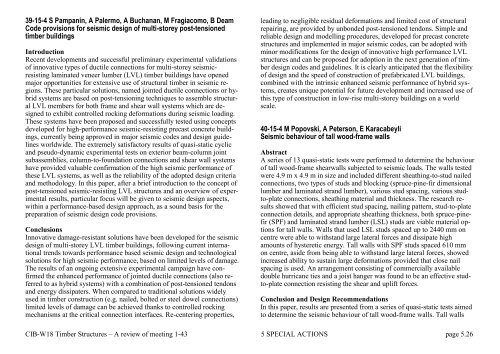CONTENT 5.1 SEISMIC BEHAVIOUR ... - CIB-W18
CONTENT 5.1 SEISMIC BEHAVIOUR ... - CIB-W18
CONTENT 5.1 SEISMIC BEHAVIOUR ... - CIB-W18
You also want an ePaper? Increase the reach of your titles
YUMPU automatically turns print PDFs into web optimized ePapers that Google loves.
39-15-4 S Pampanin, A Palermo, A Buchanan, M Fragiacomo, B Deam<br />
Code provisions for seismic design of multi-storey post-tensioned<br />
timber buildings<br />
Introduction<br />
Recent developments and successful preliminary experimental validations<br />
of innovative types of ductile connections for multi-storey seismicresisting<br />
laminated veneer lumber (LVL) timber buildings have opened<br />
major opportunities for extensive use of structural timber in seismic regions.<br />
These particular solutions, named jointed ductile connections or hybrid<br />
systems are based on post-tensioning techniques to assemble structural<br />
LVL members for both frame and shear wall systems which are designed<br />
to exhibit controlled rocking deformations during seismic loading.<br />
These systems have been proposed and successfully tested using concepts<br />
developed for high-performance seismic-resisting precast concrete buildings,<br />
currently being approved in major seismic codes and design guidelines<br />
worldwide. The extremely satisfactory results of quasi-static cyclic<br />
and pseudo-dynamic experimental tests on exterior beam-column joint<br />
subassemblies, column-to-foundation connections and shear wall systems<br />
have provided valuable confirmation of the high seismic performance of<br />
these LVL systems, as well as the reliability of the adopted design criteria<br />
and methodology. In this paper, after a brief introduction to the concept of<br />
post-tensioned seismic-resisting LVL structures and an overview of experimental<br />
results, particular focus will be given to seismic design aspects,<br />
within a performance-based design approach, as a sound basis for the<br />
preparation of seismic design code provisions.<br />
Conclusions<br />
Innovative damage-resistant solutions have been developed for the seismic<br />
design of multi-storey LVL timber buildings, following current international<br />
trends towards performance based seismic design and technological<br />
solutions for high seismic performance, based on limited levels of damage.<br />
The results of an ongoing extensive experimental campaign have confirmed<br />
the enhanced performance of jointed ductile connections (also referred<br />
to as hybrid systems) with a combination of post-tensioned tendons<br />
and energy dissipaters. When compared to traditional solutions widely<br />
used in timber construction (e.g. nailed, bolted or steel dowel connections)<br />
limited levels of damage can be achieved thanks to controlled rocking<br />
mechanisms at the critical connection interfaces. Re-centering properties,<br />
leading to negligible residual deformations and limited cost of structural<br />
repairing, are provided by unbonded post-tensioned tendons. Simple and<br />
reliable design and modelling procedures, developed for precast concrete<br />
structures and implemented in major seismic codes, can be adopted with<br />
minor modifications for the design of innovative high performance LVL<br />
structures and can be proposed for adoption in the next generation of timber<br />
design codes and guidelines. It is clearly anticipated that the flexibility<br />
of design and the speed of construction of prefabricated LVL buildings,<br />
combined with the intrinsic enhanced seismic performance of hybrid systems,<br />
creates unique potential for future development and increased use of<br />
this type of construction in low-rise multi-storey buildings on a world<br />
scale.<br />
40-15-4 M Popovski, A Peterson, E Karacabeyli<br />
Seismic behaviour of tall wood-frame walls<br />
Abstract<br />
A series of 13 quasi-static tests were performed to determine the behaviour<br />
of tall wood-frame shearwalls subjected to seismic loads. The walls tested<br />
were 4.9 m x 4.9 m in size and included different sheathing-to-stud nailed<br />
connections, two types of studs and blocking (spruce-pine-fir dimensional<br />
lumber and laminated strand lumber), various stud spacing, various studto-plate<br />
connections, sheathing material and thickness. The research results<br />
showed that with efficient stud spacing, nailing pattern, stud-to-plate<br />
connection details, and appropriate sheathing thickness, both spruce-pinefir<br />
(SPF) and laminated strand lumber (LSL) studs are viable material options<br />
for tall walls. Walls that used LSL studs spaced up to 2440 mm on<br />
centre were able to withstand large lateral forces and dissipate high<br />
amounts of hysteretic energy. Tall walls with SPF studs spaced 610 mm<br />
on centre, aside from being able to withstand large lateral forces, showed<br />
increased ability to sustain large deformations provided that close nail<br />
spacing is used. An arrangement consisting of commercially available<br />
double hurricane ties and a joist hanger was found to be an effective studto-plate<br />
connection resisting the shear and uplift forces.<br />
Conclusion and Design Recommendations<br />
In this paper, results are presented from a series of quasi-static tests aimed<br />
to determine the seismic behaviour of tall wood-frame walls. Tall walls<br />
<strong>CIB</strong>-<strong>W18</strong> Timber Structures – A review of meeting 1-43 5 SPECIAL ACTIONS page 5.26














